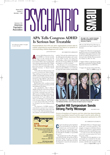A clearer picture is emerging of international medical graduates (IMGs) in U.S. psychiatry and their influence on health care services. In a report to the XIIth World Congress of Psychiatry in Yokohama, Japan, in August, Dinu P. Gangure, M.D., a psychiatry resident at St. Luke’s-Roosevelt Hospital Center at Columbia University College of Physicians and Surgeons, said that IMGs as a group bring an in-depth educational background to their clinical training in the United States. They also possess a bicultural perspective valuable in a multicultural society.
A surprising finding, said Gangure, was that in psychiatry more IMGs than U.S. medical graduates (USMGs) are likely to practice in urban areas, which was attributed to a tendency for IMGs to reside in lower-income areas of big cities. The total number of IMGs is higher now than 10 years ago, but lower than four years ago.
IMGs constitute a group of physicians whose presence on the American medical scene has become more significant over the years, and the history of IMGs in American psychiatry is closely linked to the history of mental health in this country, said Gangure. Until the 1950s, the IMGs coming to the United States were mostly European immigrants. Many gifted psychoanalysts came here to escape Nazism and enriched the already blossoming field of psychiatry.
The burgeoning growth of mental health facilities in the United States in the 1960s required an increase in personnel and was accompanied by a rapid influx of IMGs. Most of them came for training, and many of them stayed in the United States, greatly increasing the number of psychiatrists. By 1970 some 24 percent of psychiatrists here were graduates of medical schools outside of the United States and Canada. From 1972 to 1975 the percentage of IMGs in psychiatry coming from Asia doubled, and those psychiatrists are now the group with the most rapid increase in numbers, said Gangure.
Gangure noted that in the 1990s there was a steep increase in IMGs attributed to the breakup of the Soviet Union, changes in the licensing exam, and new immigration laws. Introduction of the USMLE Steps as the unique current pathway to access training in the United States simplified the process. At the end of 1994, IMGs represented 23 percent of APA members, 32 percent of residents in psychiatry, and 45 percent of first-year residents in psychiatry.
In response to concerns that IMGs might be lacking in basic technical skills, such as history taking, physical examinations, and communicating with patients in spoken English, the Educational Commission for Foreign Medical Graduates (ECFMG) mandated in July 1998 that IMGs must pass the Clinical Skills Assessment (CSA) to become certified by the ECFMG. Since then there has been a decrease in the IMG growth rate, Gangure reported. According to James W. Thompson, M.D., M.P.H., the former director of APA’s Division of Education, Minority, and National Programs, the number of IMGs matching into psychiatry dropped by 10 percent, while the number of USMGs increased by 10 percent (Psychiatric News, May 3).
A point of contention among IMGs pursuing ECFMG certification is that the CSA exams are given only in Philadelphia once a year, making it difficult for some of them to take the qualifying exam. According to the May 3 Psychiatric News article, this concerned Thompson, as a decreased pool of IMGs would hurt several medical specialties, and psychiatry has increasingly relied on IMGs over the last several years.
Gangure reported that from the beginning of the certification process in 1998 through 2001, the number of IMG candidates taking the Step I examination dropped by 45.5 percent (36,983 to 16,828), and those registered for Step 2 dropped by 38.1 percent (31,751 to 12,122). The number of ECFMG certificates issued each year dropped from a range of 9,000 to 12,000 from 1995 to 1998 to fewer than 6,000 from 1998 to 2001.
It is important to be aware of differences among IMGs, Gangure said. One aspect is that the designation of IMG does not automatically imply the person’s legal status in the U.S. Some IMGs are American-born citizens who went to medical schools overseas; others are naturalized American citizens who decided to enter residency training; some immigrated to the U.S. to be with their families; while still others are here on various types of visas permitting them to work for varying lengths of time in the U.S. To avoid confusion, it is good to know that IMGs are a heterogeneous group of physicians.
The most important question remains of how best to meet Americans’ need for psychiatric services, Gangure pointed out. Thousands of needy people lack psychiatric care simply because there aren’t enough psychiatrists in certain areas. If a map of underserved areas is superimposed over a map of the distribution of psychiatrists throughout the U.S., it becomes clear that some large metropolitan areas have an overabundance of psychiatrists, while rural and poor urban areas are lacking in coverage. Programs like loan forgiveness for USMGs and J-1 visa waivers for IMGs could reestablish an equilibrium between the distribution of psychiatrists and needs in the country.
Another area of major interest is the highest level of research in psychiatry, Gangure said. He advocates continuing to attract the best minds to psychiatric research, from both the pool of USMGs and IMGs, to assure the fastest advance of psychiatric knowledge.
Since Gangure’s study, a “special communication” by Gerald P. Whelan, M.D., and colleagues of the Educational Commission for Foreign Medical Graduates titled “The Changing Pool of International Medical Graduates Seeking Certification Training in U.S. Graduate Medical Programs” in the September 4 JAMA states that “IMGs consistently represent approximately one-fourth of both the physician workforce and the graduate medical education (GME) population of the United States.”
Gangure believes that IMGs as a group have the potential to infuse the American psychiatric stream of thought with universal values and make important contributions to psychiatric education and research. ▪
